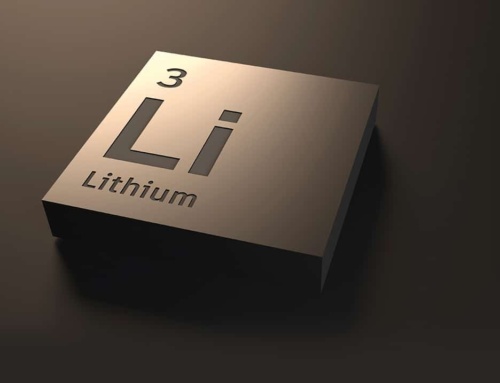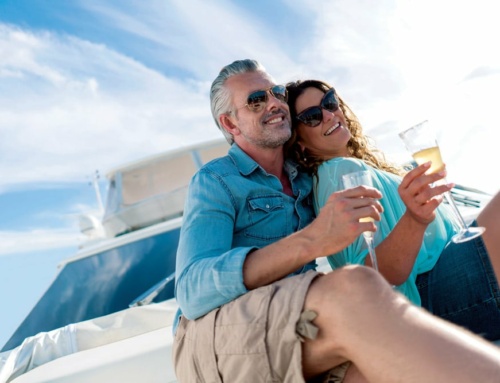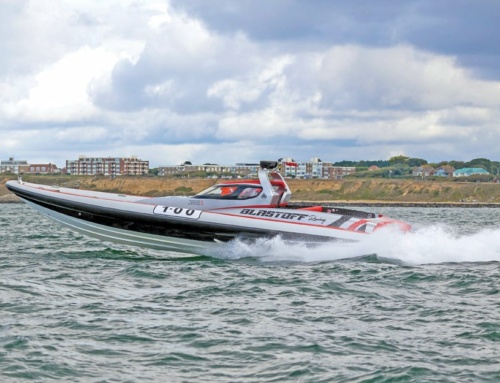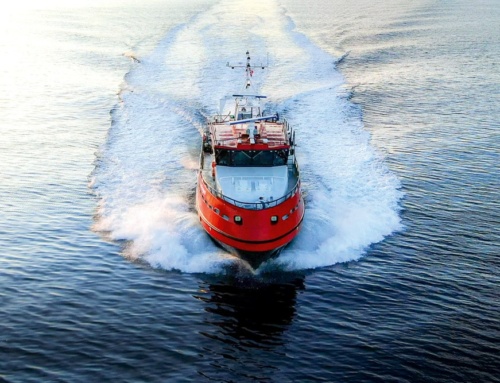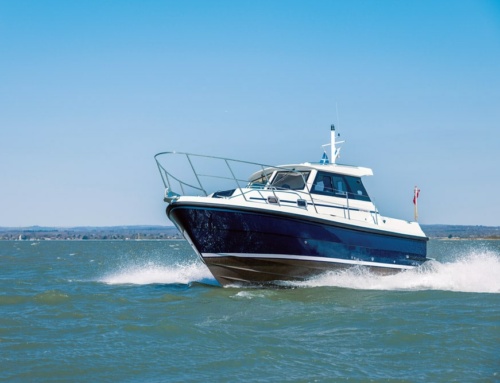- Fortunately, all the complications involved in designing and building a great stepped-hull boat are the boatbuilder’s to solve, not yours.
- Extra reinforcement is required to bridge the structural discontinuity across the steps, and stepped hulls are not as simple to laminate.
- At speed, driving through waves, stepped-hull boats invariably pitch and porpoise far less; their ride is more resolute, consequently they invariably slam less.
Stepping Out
Dave Marsh explains how stepped hulls work and examines the pros and cons …
The question we should be asking ourselves is: why don’t the designers of planing boats use stepped hulls for all their boats? Because on the face of it, the advantages are profound. Improved fuel efficiency and a higher top speed are the well-known headline benefits. To those gains we can add a more level ride, better forward visibility, less pitching, reduced slamming and typically less spray. That’s a roll call of crucial benefits that every naval architect should be aiming for on every boat. So the fact that all planing hulls are not stepped implies that the process is not entirely straightforward.
Theory
It helps to have a clear understanding of how stepped hulls work, especially as they still seem to be a magnet for fake news. Ideas such as stepped hulls gliding along on a cushion of air bubbles, or the increased efficiency being entirely due to the aerated water reducing skin friction, are among the sillier notions. Fortunately, the key hydrodynamic principles are fairly straightforward. Just like the wing of an aircraft, the underside of a planing hull develops lift and drag. And just like an aircraft wing, the majority of the lift is generated at the front of the surface. This is why planing hulls lift their bows – if the lift was predominantly at the stern, they would lift their sterns, and we’d all travel much more slowly! Likewise, the efficiency of a lifting surface – hull and wing alike – improves as its aspect ratio increases. We shan’t delve into the aero- or hydrodynamic principles that underpin this crucial issue – there’s so much visible evidence around that we probably instinctively understand this anyway. In nature, we have the pronounced wingspan of soaring birds such as albatrosses, frigates and vultures. In the boating world, we see high-aspect rigs on race boats, and likewise their enormously long, thin keels and foils. Gliders may be the ultimate exemplars, because their singular goal is to maximise the lift:drag ratio from their slender, ultra-high-aspect-ratio wings.
What the steps do is to break the customary single long hull surface into smaller sections (almost invariably three sections, using two steps) by channelling air into the steps. On production boats, this normally takes place by natural means, by carefully shaping the break in the chine so that air is drawn into and along the step. However, it is also possible to force-feed the step by funnelling air through tubes that emerge under the boat, along the upright face of the step. Giant boatbuilders Beneteau use this technique for their innovative Air Step hulls.
This stepping has three significant effects. In place of a single long hull surface, which is generally about three times as long as it is wide, a twin-stepped hull forms three smaller lifting surfaces that are almost twice as wide as they are long (if that geometry doesn’t seem to add up very well, it’s because the water doesn’t immediately reattach to the hull after it breaks away across the step). So we’ve moved from an aspect ratio (AR) of 1:3 to an AR of 2:1 – a sixfold increase. That is a significant change that translates into far better lift:drag figures.
Those three separate surfaces also distribute the lift far more evenly along the hull bottom. This is because the aftermost surfaces also have their own leading edges, which in turn generate the higher levels of lift that we’ve already noted occur around the front of a lifting surface. This is the principal reason why stepped-hull boats run at lower angles of trim, typically 2 to 3 degrees, compared with the 4 to 6 degrees I generally record on conventional boats.
The third effect is reduced skin friction. If the hull’s lifting surfaces are more efficient (i.e. greater lift), it follows that at any given speed, higher lift translates into less boat in the water, ergo less frictional drag. Doubtless there is also some beneficial effect coming from the reduction in drag due to the turbulent mixture of air and water immediately behind the step reducing skin friction, but it’s unequivocally not the principal reason why stepped hulls are more efficient.
Practice
So how much more efficient are stepped hulls? That depends on whether the designer has optimised the hull for all-out top speed, or if, instead, the quality of the ride and the handling was the principal goal. Typically, though, the builders I talked to said potentially up to 15% if it’s the former, and down to around 7% if it’s exclusively the latter. However, anecdotal evidence and our testing suggest that few boats stray far from a figure of 10%. Because there is so little quantitative data available that directly compares otherwise identical stepped and non-stepped hull forms throughout the speed range, rather than just at top speed, it’s not easy to determine where those efficiencies manifest themselves – throughout the range or just at the top end? Having said that, on the best stepped-hull boats I’ve been lucky enough to drive – boats from the likes of Axopar, Hydrolift, Nimbus, Pascoe and Scorpion – climbing through the rev range, I’ve never once experienced any form of inexplicable Star Trek-like acceleration from impulse to warp drive, which strongly suggests that the efficiencies are there throughout the speed range as soon as these boats are up on their steps and fully planing.
Although that median 10% sounds terrific, the benefits can be more impactive still. A jump from, say, 40 to 44 knots may provide the owner with 10% lower fuel bills. However, because a boat’s speed is proportional to the square of its power, achieving that increase in top speed on the non-stepped counterpart would require a 21% increase in power. And that’s assuming the bigger engine didn’t incur a weight penalty. Flip this on its head, and on twin-engine boats that are light and fast, the stepped hull can provide the starting point for a virtuous circle of efficiency. Moving to a stepped hull provides the first 10%. Then switching from twin engines to a single typically provides around 25% more, due to shedding the drag from the second leg. Then there’s another separate gain from jettisoning the weight of the second engine. As Scorpion discovered to their delight, one of their twin-stepped Serket 90STs with a single 300hp outboard performed almost as well as their non-stepped Serket 98 with its twin 300hp. Don’t expect to see such dramatic gains on your big comfy cruisers – they’re normally only evident on lighter, faster boats where the weight of the engines represents a large proportion of the overall weight of the boat.
Joyriders
As financially helpful as that 10% efficiency gain is, for me the real joy of the very best stepped-hull boats is the way they ride and handle. Distributing the lift provides several interrelated benefits. With more lift aft, they ride more level, so forward visibility is improved. On a RIB with a large inflated nose, sometimes this can make all the difference between seeing safely over the bow and struggling to see around a bulbous rubbery snout. At speed, driving through waves, stepped-hull boats invariably pitch and porpoise far less; their ride is more resolute, consequently they invariably slam less.
In rough weather, when they do become airborne, those lower trim angles translate into more level flight and a softer landing, because the deeper forward V sections have more chance of taking the impact, rather than the flatter aft sections. Less pitching and slamming typically means less spray too – another thumbs-up for visibility. Some builders also report other benefits. Axopar reckon that their hulls, which they design foremost with ride quality in mind, are more dynamically stable (transversely) and lean over less in the turns. Although the extra drag from the steps at pre-planing speed may slow stepped boats a little until they lift onto the plane, typically their transition onto the plane is more subtle, courtesy of those more resolute trim angles again.
This all adds up: stepped-hull boats invariably provide a more comfortable ride in similar conditions, and when you do want to press on, their better balance and softer ride make it easier to maintain a higher average top speed. Although it’s a subtle difference that’s difficult to detect, in a light chop I would judge some stepped boats to be very slightly noisier due to the water hitting the multiple steps, although that is counteracted by the reduced slamming as the wave height climbs.
The elephant
Ah, but what about the elephant in the room – the notion that stepped-hull boats require more elevated skills and are more difficult to drive safely, and at worst are capable of tripping over themselves in high-speed turns and potentially ejecting and injuring their occupants? Well, the answer is yes and no. No because the best builders and designers, especially those with a long history of designing, developing and testing stepped-hull boats, are nowadays unquestionably capable of designing stepped boats that are actually as easy or even easier to drive than their non-stepped counterparts, and are just as safe. I feel confident in stating this, rather than just alluding to it, because this has been my first-hand experience. And that includes a trip from Sweden to England in a stepped-hull Nimbus Nova 300R, and two years running a Nimbus Nova 250R. In fact, I prefer the cornering characteristics of some stepped-hull boats. Some of the small deep-vee sports boats with conventional non-stepped hulls are capable of cornering so hard that you risk disconnecting internal organs, whereas stepped-hull boats generally provide a softer experience.
However, there are stepped-hull boats out there that are much trickier to handle safely. I’ve driven two that were so skittish that even in the gentle chop in which I tested both, I felt that the boats were actually in control of me, not the other way round. OK, these were both designed to go very fast – one did 80mph, the other 74mph – but their edgy nature was apparent long before they reached top speed. In fact, the slower boat did eject a friend of mine from his seat when he drove over another boat’s very modest wake. So our advice is to always insist on a test drive and ask some probing questions. If your salesman looks nervous when you suggest some hard high-speed turns or finding some rough water, ask why.
Pros and cons
So, given that well-designed stepped-hull boats offer so many advantages, why don’t the designers of planing boats use stepped hulls for all their boats? Well, although the best designers clearly can and do get it right, it’s no easy task. The designer of a conventional planing boat already has myriad variables to juggle. Stir in a couple of steps and they also have to determine their shape and size, their positioning, whether they face aft or run straight across the boat or lean forward, whether they’re straight or curved, the crucial shaping of the air intake around the chine, whether the keel line will run straight or slope down between the steps, what to do with the spray rails that run between the steps, and so on.
It’s more costly to build a stepped hull too – perhaps not much in the overall scheme of things (between 3% and 5% was the most precise answer I received) but still an unwelcome cost. Extra reinforcement is required to bridge the structural discontinuity across the steps, and stepped hulls are not as simple to laminate. There’s also the added complexity of draining the water that can collect in front of the steps.
Fortunately, all the complications involved in designing and building a great stepped-hull boat are the boatbuilder’s to solve, not yours. Of course, your dream boat may not be one that offers you the choice between a stepped hull and a conventional boat, but if you do have that option, go try one – you may well rediscover that ridiculous ear-to-ear grin you used to sport as a child.

